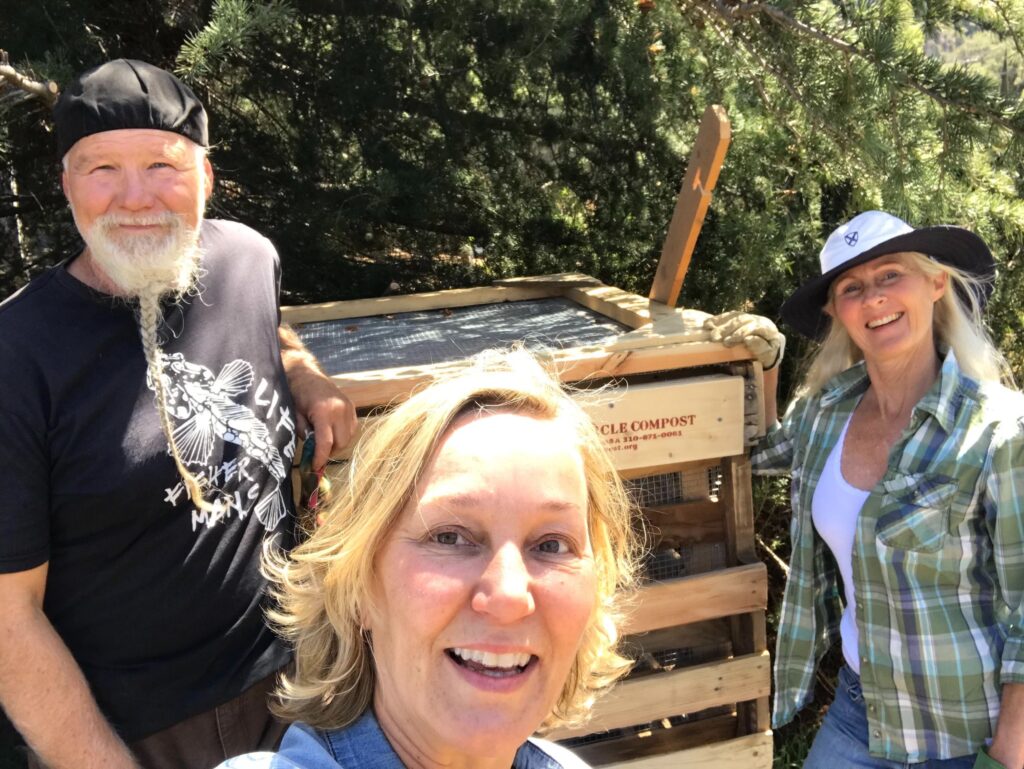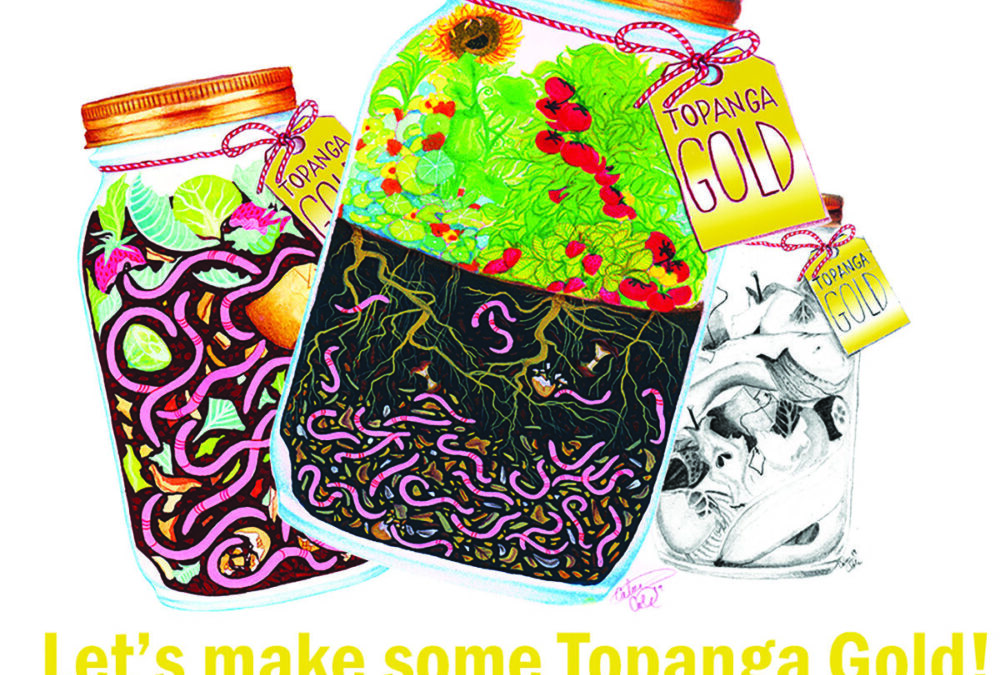Waste /wAYst/ n. any unwanted material or substance that results from a human activity or process. Damaged, defective, or superfluous material
Resource /ˈrēˌsôrs,rəˈsôrs/ n. a source of supply, support, or aid, especially one that can be readily drawn upon when needed
Banana peels, apple cores, orange rinds, coffee grounds, kale stems, egg shells, bell pepper seeds, tea bags, carrot tops, peach pits, strawberry hulls, onion skins… these are the parts of food that we throw away and see as inedible, less tasty, of no use. Our ancestors would use some to make a soup stock and the rest to feed animals. Very little would go to waste. We have been disconnected from many of those traditions and the lifestyle that would make them useful.
Organic waste is the largest waste stream in California. When organic matter in our landfill is deprived of oxygen, it creates methane as it breaks down. Carbon dioxide gets a lot of attention, but methane is a major contributor to greenhouse gases. While it is a short-lived pollutant (meaning it remains in the atmosphere for a shorter period of time), it is a super pollutant. Over a 100-year period it impacts greenhouse gas emissions 34-36 percent more than carbon dioxide, but over a 20 year period, it has a global warming impact 84-86 percent greater than CO2. As we try to minimize our carbon emissions and look to green energy strategies, we must also take a hard look at our relationship with waste, especially food waste.
In January 2022, Senate Bill 1383, which was signed into law in 2016 by Governor Jerry Brown, will finally go into effect across California. In addition to requiring California to divert 20 percent of recoverable food to those in need, it requires a 75 percent reduction of organic waste in our landfills by 2025.
Residents and businesses will have organic waste collection service provided and trash hauling prices will increase. This will have a large financial impact on restaurants, schools, and grocery stores, because of the amount of food waste they create. The cost of hauling it to a centralized waste system will be significant as organic matter is very heavy.
SB 1383 will require 50-100 new or expanded organic waste recycling facilities to manage the enormous amount of organic waste that will be collected. This will help to minimize heavy truckloads on lengthy drives to far off compost sites. Additionally, we will have the challenge of dispersing the processed compost. More heavy truckloads on lengthy drives to get the compost to where it can be used is costly in terms of fuel, new trucks, and labor, not to mention an entirely new education and coordination arm for each jurisdiction. While this new bill offers us a clear path to decrease methane gases, we don’t yet have the infrastructure in place and will be navigating much new territory.
SB 1383 is supported by a landscape ordinance (MWELO, the Model Water Efficient Landscape Ordinance) that requires all new and remodeled landscapes (500 sq. ft. + and 2500 sq. ft. +, respectively) to use compost (four 4 cubic yards per 1000 sq. ft.) and mulch (3 inches on exposed soil) and will also restrict water use.
This will benefit the health of the plants as compost suppresses weeds and pests and reduces the need for chemical fertilizers, but it also retains more water. A 5 percent increase in organic material quadruples the soil’s water holding capacity. This increases the evapotranspiration rate (the sum of evaporation from the land surface and from plant transpiration) and minimizes erosion.
Some of our forward thinking locals are spearheading projects to prepare Topanga. After years of successful home composting, our very own Topanga New Times owner and publisher, Bonnie Morgan, fostered a partnership between nonprofit LA Compost and the Topanga Community Center to create a community compost hub she calls “Topanga Gold.”
“Compostable kitchen waste makes up nearly 40 percent of the material we send to the landfill,” Bonnie explained. “Having a composting hub in Topanga is a tremendous step forward towards zero waste. It’s one of the biggest things we can do to reduce waste.”
TCC members can bring their food waste (fruit and vegetable scraps, egg shells, coffee grounds, spent flowers, and shredded newspapers) to the hub and then, when ready, they can receive some of the nutrient-rich compost to use in their gardens.
The hub was launched in late 2019, just months before TCC closed because of COVID-19, and the hub has only recently opened up again. Check the TCC website to learn how members can participate in diverting food waste, making compost, and building community. To become a member go to: topangacommunitycenter.org

Another effort, the nonprofit Full Circle Compost led by Cecilie Stuart, is bringing large compost bins and guidance to our local schools and businesses. Cecilie has been passionate about climate solutions and has worked for years with teens to bring awareness and inspire activism.
After many years of leading Move the World, a dance activism nonprofit, she began offering Drawdown workshops and classes to Manzanita School and the greater community. In 2019, she turned her focus to food waste and compost. She recognized that, “on the list of the top 10 things that can be done to tackle global warming, three of them are things we can all do: eating less meat, buying/wasting less food, and composting. There is no ‘away,’” says Cecilie. “It’s a challenge to change our habits, but we need to decentralize waste.”
Full Circle Compost has worked with The Love School and Calabasas Klubhouse Preschool to set up compost systems for school use and also as a drop-off hub for school families. Full Circle is also about to launch an exciting new hub at Pine Tree Circle for the businesses there.
Cecilie has worked closely with Pine Tree Circle’s owner, Nate Daneshgar, who says, “This is a collaborative effort between Full Circle Compost, The Well, and Pine Tree Circle. We (the ownership) are purchasing the compost bin from Full Circle, plus composting equipment. Full Circle will install the compost bin and provide training to Pine Tree Circle businesses, and The Well will be servicing it.”
Pine Tree Circle will have a small ribbon cutting ceremony for all the businesses involved very soon.
Keeping our food scraps in town to make locally-used compost offers many benefits to our ecosystem. Rich organic matter supports microorganism life so that dry, dusty, dirt can become a soil sponge. Water can be absorbed into the earth more readily and retained longer. The carbon in organic matter is the main source of energy for soil microbes that are key for making nutrients available to plants.
Plants sequester carbon and cool the temperature of the earth. When plants are more nourished and supported by improved soil structure, evapotranspiration and humidity levels in the immediate environment are elevated. Because plants break the fall of even the heaviest rains, the soil has more time for absorption, and run-off is minimized, which protects our watershed. We can actually transform our microclimate with that retained humidity, and create a small water cycle that can have a positive impact on rainfall. Up to two thirds of precipitation on land comes from small water cycles. After years of drought, wildfires, and heat waves, it’s time to reassess what we throw “away” and reframe waste as the valuable resource that it is.
Full Circle Compost is holding a monthly compost meet-up on the 4th Sunday of each month, with composting information, and free seedlings. They are looking to connect and build enthusiasm for this movement. Reach out to Cecilie to volunteer, to meet up, or to inquire about setting up a compost system for your business: [email protected].
Delmar Lathers, a (longtime Topanga resident, Manzanita School teacher, ceramicist, and jack-of-all-trades,) has teamed up with Cecilie to build up-cycled wooden pallet compost bins and they always welcome volunteers.
Composting resources:
The EPA’s Food Recovery Hierarchy:
- Reduce the amount of food produced— We are all accustomed to over-full grocery store shelves, but much of that food ends up wasted in trying to give us a feeling of abundance. Buying less and locally from farmers decreases the amount of food lost in transit and expiring at the supermarket.
2.First feed people— there is an abundance of edible food getting thrown into landfills every day. Grocery stores are now donating perfectly good grocery items to food pantries and other nonprofits that distribute food to those that are hungry and food insecure. These items are not yet expired, but not as fresh as the new stock coming in and they have previously been thrown in the trash. Thanks to organizations like Nourish LA, Abound Food Care, Spoiler Alert, and many other nonprofits, much of it is made available to the 23% of Californians that are food insecure and also diverts organic matter from our landfills.
3. Feed animals— when food isn’t fit for people to eat, it is often still nutritious food for animals. Healthy animals need a varied diet and a range of nutrients that are not readily found in commercially processed animal feed.
4. Green energy— many exciting new technologies exist; one technology called anaerobic digestion uses food waste to make electricity. As organic waste decomposes, the methane is captured rather than released into the environment and used as power. This is much more common in Europe, but the technology is slowly gaining popularity here in the U.S.
5. Compost— any organic waste that can’t feed people or animals, or be transformed into energy, can be composted to make rich, fertile soil. Compost feeds plants, improving the nutrient quality of the food we grow, in turn improving our health.
6. Landfill— our last resort.













